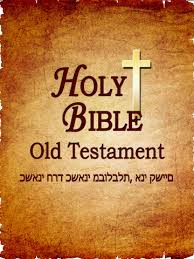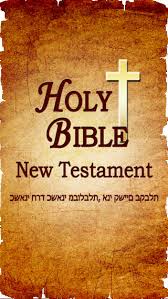I have often heard skeptics of the Christian Bible say that the Old and New Testaments have no connection and that the God of the Old Testament is not the same as the God of the New Testament. Most skeptics have never really studied the Bible – I know cause I was one of them. Reading and studying are two different things.
If you want to know the truth about something you need to study it. Studying often means looking at arguments from both sides and making a determination about the evidence those sides present. Just like in a court of law we must ask the question which side makes their case beyond a reasonable doubt? What I have found is that the Bible does just that, it is like death by 1000 paper cuts, you can knock down one piece of evidence but there are 999 more pieces!
With the Bible, or any book that you want to learn more about, you must read it with some background in mind. In previous posts we have discussed the use of hermeneutics please check that out if you are planning a study, but here are five essential things to keep in mind concerning the Bible and the Old Testament in particular:
1. Research the author, audience, genre’ and purpose of the book. Many study Bibles do this for you, but you can go outside the Bible for this information as well. It is important to note that the Bible is made up of 66 individual books with 40 different authors from various stations of life who wrote over a period of 1500 years from various places, yet they all write with a cohesive theme.
2. The major Bible versions today have been directly translated from the original languages (not through multiple translations as some skeptics claim). The Old Testament was written in Hebrew, with a part of Daniel and Ezra in Aramaic, and the New Testament was written in Greek. These were the perfect languages because the Hebrew is very ‘pictorial’ and conveys narratives that are easy to translate. The Greek was the ‘English’ language of the day, it was well known in the modern world of the first century AD and it could easily be disseminated into various parts of the then known world as it rapidly was, and it is easily translated today.
3. The Old Testament has many layers of theological teachings that directly tie to the New Testament:
- It starts with a Promise God makes immediately after the Fall (Genesis 3); it then unfolds in a Covenant with Abraham (Genesis 12); it continues to expand throughout the history of the Nation of Israel with the Mosaic Covenant (the Law) and later with a specific promise to King David of an eternal Royal line called the Davidic Covenant (1 Chronicles 17); it then culminates with the New Covenant through the fulfillment of the Old in the person of Jesus (Matthew 26, Luke 22, 1 Corinthians 11, Hebrews 8,9, and 12). All of this leading to a future event where we will be able to return to that original relationship lost in the Garden with Jesus, the eternal ruler who will make all things new:
Then I saw a new heaven and a new earth; for the first heaven and the first earth passed away, and there is no longer any sea. And I saw the holy city, new Jerusalem, coming down out of heaven from God, made ready as a bride adorned for her husband. And I heard a loud voice from the throne, saying, “Behold, the tabernacle of God is among men, and He will dwell among them, and they shall be His people, and God Himself will be among them, and He will wipe away every tear from their eyes; and there will no longer be any death; there will no longer be any mourning, or crying, or pain; the first things have passed away.” And He who sits on the throne said, “Behold, I am making all things new.” And He *said, “Write, for these words are faithful and true.” Revelation 21:1-5
- This historical unfolding of God’s original Promise is further supported throughout the Old Testament with hundreds of fulfilled prophecies, some with so much detail they even name people like Josiah and Cyrus hundreds of years before they were born, and so many more fulfilled in the life and times of Jesus. It would also be important to note that the Bible contains many others that are futuristic, or apocalyptic in nature (related to end times).
4. The Old Testament contains historical accounts of events and times that have been confirmed (see information on the Dead Sea Scrolls), and are still being confirmed through archeological discoveries and non-Biblical records including the history of the people of Israel whom God chose to be His representatives and the Nation from which He would choose to send His Son. Even up until the time of Jesus, most Jews could trace their lineage to one of these tribes:
The Twelve Tribes of Israel (and some notable descendants):
- Reuben
- Simeon
- Levi (Arron, Moses, Eli, John the Baptist)
- Judah (David, Joseph and Mary, Jesus)
- Zebulun
- Issachar
- Dan (Sampson)
- Gad
- Asher
- Naphtali
- Joseph* (Joshua, Deborah, Gideon, Samuel)
- Benjamin (King Saul, Esther, the Apostle Paul)
*Joseph’s tribe was split into two tribes: Ephraim and Manasseh
5. Another thing we find studying the Old Testament is a “foreshadowing” or typology of Jesus in many of the Old Testament figures. One example of this comes in the person of Joseph, one of the twelve sons of Jacob (Israel). In his story (Genesis 37-50) he is the favored son of Jacob but is despised by his brothers. They ultimately sell him into slavery and he ends up in the prisons of Egypt. In the end Joseph is appointed second in command of Egypt and is reunited with his family. One might think that Joseph would be bitter and resentful but in the end he gets it and proclaims:
“Now, therefore, it was not you who sent me here, but God; and He has made me a father to Pharaoh and lord of all his household and ruler over all the land of Egypt.”… “As for you, you meant evil against me, but God meant it for good in order to bring about this present result, to preserve many people alive.” Genesis 45:8; 50:20
A few of the many parallels between Joseph and Jesus:
- Their fathers loved them dearly and suffered the temporary loss unto death
- Shepherds of their father’s sheep
- Sent by fathers to brothers
- Hated by brothers
- Sold for the price of a slave
- Taken to Egypt
- Others plotted to harm them
- Tempted
- Robes taken from them
- Bound in chains
- Falsely accused
- Placed with two other prisoners, one who was saved and the other lost
- Both 30 years old at the beginning of public recognition
- Exalted after suffering
- Forgave those who wronged them
- Saved their nation
- What people did to hurt them God turned to good
Joseph is an early example of what God would do for all of us through his Son Jesus. His story gives us a glimpse of the big picture God had set out. We find many examples of this throughout the Old Testament in the lives of people like Moses, Joshua, Samuel and others. It is amazing to me that skeptics would continue to claim a disconnect between the Old and New Testaments because the connections are many and inescapably obvious!
In Conclusion: All of the Biblical narratives and teachings point to the need for redemption and the promise of someone coming to save humankind from their perversion of God’s intended way of life and their perversion of the relationship with Him. It is important to note that the Bible reports real history (as supported by archeology and non-Biblical historical records) and many of the horrible events recorded are the result of human choice and action, not God’s direction. If read (and studied) carefully you will find that the loving, righteous, holy and just God of the New Testament is the same one in the Old Testament and He is full of grace for those with true hearts of repentance, and righteously just for those who arrogantly are not.
The fear of the LORD is the beginning of knowledge; fools despise wisdom and instruction. Proverbs 1:7
Note: The believer’s fear is respect for, and reverence of, God (Hebrews 12:28-29); for the non-believer it is eternal separation from God (Luke 12:5; Hebrews 10:31).
For a little more on the historical veracity of Scripture watch this 30 minutes clip with Dave Stotts from his Drive thru History series:
Join us next week as we continue our study into the history of the Old Testament and its connection to the New.
—————————————————————————————————————————————————————-
You will not find this material in the public school curriculum even though it is based on solid evidence and grounded in research. It is ironic that following the evidence to where it leads stops at the door of our public schools as they will not let a “Divine footprint” in! Join us this year as we examine evidence for Christianity and learn how to become a thoughtful defender and ambassador of your faith.
Click into the resource page of this website to view many of the top Christian thinkers and apologists along with some of their work; connecting to these types of resources is essential in your Christian growth.
Please let me know what you think: Give feedback, ask questions or send concerns in the comment section of the blog.
Teri Dugan
TeriDugan@truthfaithandreason.com
1 Peter 3:15




Sorry, comments are closed for this post.